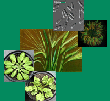| Deinlein, U; Weber, M; Schmidt, H; Rensch, S; Trampczynska, A; Hansen, TH; Husted, S; Schjoerring, JK; Talke, IN; Krämer, U; Clemens, S: Elevated nicotianamine levels in Arabidopsis halleri roots play a key role in Zn hyperaccumulation., Plant Cell, 24, 708-723 (2012), doi:10.1105/tpc.111.095000 | |
| Abstract: Zinc deficiency is among the leading health risk factors in developing countries. Breeding of Zn-enriched crops is expected to be facilitated by molecular dissection of plant Zn hyperaccumulation, i.e. the ability of certain plants to accumulate Zn to levels > 100-fold higher than normal plants. The model hyperaccumulators Arabidopsis halleri and Noccaea caerulescens share elevated nicotianamine synthase (NAS) expression relative to non-accumulators among a core of alterations in metal homeostasis. Suppression of AhNAS2 by RNAi resulted in strongly reduced root nicotianamine (NA) accumulation and a concomitant decrease in root-to-shoot-translocation of Zn. Speciation analysis by size-exclusion chromatography coupled to inductively coupled plasma mass spectrometry showed that the dominating Zn-ligands in roots were nicotianamine and thiols. In AhNAS2-RNAi plants a marked increase in Zn-thiol species was observed. Wild-type A. halleri cultivated on their native soil showed elemental profiles very similar to those found in field samples. Leaf Zn concentrations in AhNAS2-RNAi lines, however, did not reach the Zn hyperaccumulation threshold. Leaf Cd accumulation was also significantly reduced. These results demonstrate a role for AhNAS2 in Zn hyperaccumulation also under near-natural conditions. We propose that NA forms complexes with Zn(II) in root cells and facilitates symplastic passage of Zn(II) towards the xylem. |

